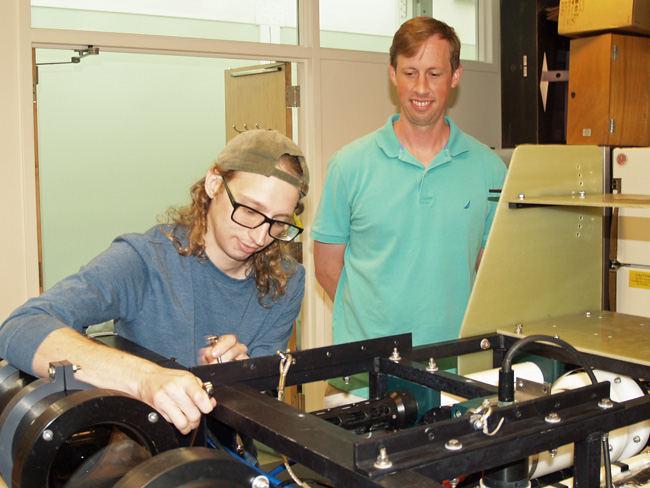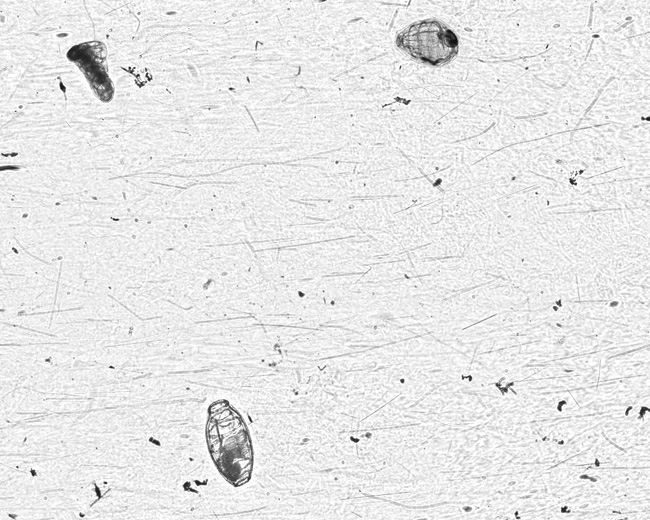University of Georgia Skidaway Institute of Oceanography biologist Adam Greer studies marine life from the bottom up (of the food chain, that is). Greer investigates plankton – organisms between approximately one millimeter to several centimeters in size – adrift in the water column. He uses a new, cutting-edge imaging system that reveals more of this microscopic world than has ever been possible before.
“I study tiny organisms in the ocean, and I’m interested in how they interact with their ocean environment – how the environment impacts them and how they interact with each other,” Greer said. “Mostly, I am interested in the early life stages of some of the fish and what happens to them when they are really small.”

Adam Greer (r) and graduate student Patrick Duffy perform post-cruise maintenance on the mini Deep-Focus Plankton Imager (mDPI).
Greer’s lab group currently focuses mostly on gelatinous organisms, what they eat and how they move around in the ocean currents. Most are very small and often go unseen, and as a result, they are very poorly understood. However, they are an important part of the marine ecosystem, and depending on the particular species, they can play different roles. Some gelatinous species also impact the populations of much larger animals, like fish, by eating their larvae.
“Seafood is a multi-billion-dollar industry, so it’s pretty important to understand the fundamental processes that are affecting fish populations,” he said. “There is a lot of fish larvae out there. A lot of them are being eaten by predators, and we don’t know really at what rates and what kinds of environmental things could influence that mortality and the abundances on down the line.”
Traditional sampling methods, like towed plankton nets, are valuable because they provide a tangible sample for analysis. However, they cannot provide a picture of marine organisms in their natural environment and allow scientists to observe their interactions. For that, Greer and his fellow researchers utilize a high-tech imaging system that is towed behind a research vessel. The In Situ Ichthyoplankton Imaging System and similar iterations of that instrument (such as the mDPI pictured above) record thousands of high-resolution images of marine organisms along with precise depth location of each individual.
The imaging system is built around two pods with a camera in one pod and a light source in the other. As it is towed through the water, the plankton flow between the two pods and, if plankton are present, each individual blocks the light from reaching the camera. The camera picks up the shadows of the plankton that scientists or computer algorithms can identify. The system allows scientists to look at a large volume of water because all of the shadows are in focus.

An image from the In Situ Ichthyoplankton Imaging System showing several plankton, including 3 barrel-shaped gelatinous animals known as doliolids.
“If you’re interested in gelatinous plankton, fish larvae, things like that, they’re not that common compared to other plankton,” Greer said. “And so, you have to actually look at a lot of water to find those types of organisms. If you’re looking at too small of a volume, you won’t really run into things that are relatively rare in the plankton world like fish larvae and gelatinous organisms.”
Typical abundances for fish larvae are one individual per approximately 250 gallons of seawater, but there is a wide range observed in different marine ecosystems.
Researchers can see what each individual is experiencing in the environment and where they are in the water column. They can also observe the characteristics of their environment like temperature, salinity and dissolved oxygen concentration.
“That’s a lot of information that we were just missing until now,” Greer said.
The imaging system also provides insight into which organisms are sharing the same space and how they interact. Which species is a predator and which species is the prey? What organism is a parasite to another? How do organisms move from one set of ocean conditions to another as they go through life stages?
Greer says each deployment is an adventure.
“Every time we put it in the water, I feel like we see something new and something unexpected. And so that’s really the exciting part about these camera systems is that it’s really just a new view of how ocean life is interacting with each other and the environment.”
Greer recently published the results of some of his work in the ICES Journal of Marine Science. The paper can be viewed at https://academic.oup.com/icesjms/advance-article/doi/10.1093/icesjms/fsab149/6350848


